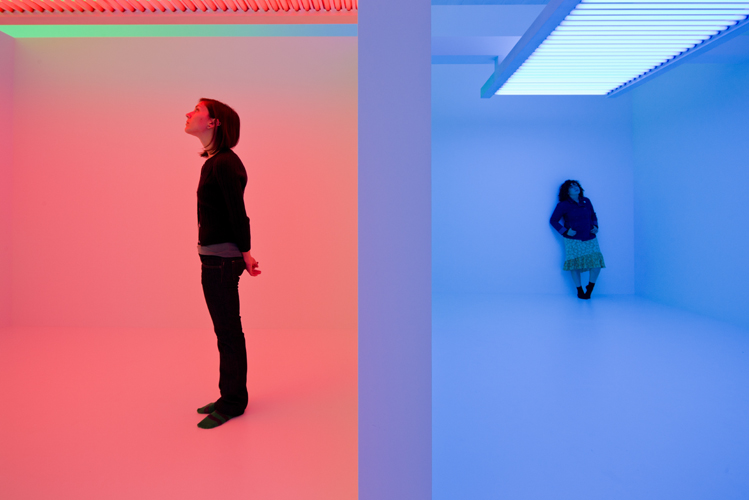Treat Your Senses to Hirshhorn’s New Suprasensorial Exhibition
/https://tf-cmsv2-smithsonianmag-media.s3.amazonaws.com/filer/20120228023003BlueForestCrop.jpg)
![]()
The Hirshhorn Museum‘s new exhibition, “Suprasensorial: Experiments in Light, Color and Space,” is something meant to be experienced. Installations by five Latin American artists whose participatory works tease the senses while incorporating the viewers’ own perceptions into the final experiences breach the theatrical fourth wall. The works literally draw you in and from within, a drama unfolds.
The international group of artists operated on parallel innovative paths, and even served as precursors, in some cases, to the Southern California-based Light and Space art movement of the late 1960s. Alma Ruiz from the Museum of Contemporary Art, Los Angeles, is serving as guest curator for show.
“For me, the most important aspect of the exhibition is to show how avant-garde these artists were at the time–how they conceived art in a different way.” said Ruiz. “It was a different dynamic between the audience and the artwork.”
The works are best experienced on a first-hand basis, just as the artists desired. “They wanted to actually make that space between the viewer and the object disappear,” said Ruiz. “They wanted people to really immerse themselves in the art.”
WARM…WARMER…DISCO:
Step into the ever-changing disco ball light show inside the mirrored cave of Argentinian Julio Le Parc’s 1962 Light in Movement (refabricated 2010) and it becomes easy to linger. The rotating mirrored panels send beautiful, ever-changing light across the interior of the installation. It’s like stargazing indoors and watching the universe slowly revolve around you.
SHAKE YOUR BOOTIES:
“It’s about the color saturations,” said Hirshhorn curator Valerie Fletcher, of the 1965 Chromosaturation by Venezuelan Carlos Cruz-Diez’s (refabricated 2010). A visually intense experience, the blindingly white walls, ceilings and floors inside the structure provide a sharp counterpart for the striking florescent color grids of blue, magenta or green fixed to the ceilings. Help keep things clean and throw on a pair of the protective booties provided by the museum before entering this room.
Immerse yourself in the works that surround and submerge you at the Hirshhorn. Carlos Cruz-Diez, "Chromosaturation," 1965, refabricated 2010. ©2012 Artists Rights Society (ARS), New York/ADAGP, Paris. Photo: Iwan Baan
THE BLUE FOREST:
Venezuelan Jesús Rafael Soto creates a sense of artistic whimsy with his 1969 Blue Penetrable BBL (refabricated 1999), as the viewer steps into a sea of hanging blue rubber strands–a virtual cerulean spaghetti forest. Like the brushes in a car wash, the rubber grabs at you and engulfs you as you make your way through. The best part? Looking up while standing in the middle and seeing only blue lines.
LAY DOWN, TUNE IN:
Need a place to take a nap? The very informal atmosphere of the early 1970s is recreated in the 1973 Cosmococa: Program in Progress, CC1 Trashiscapes (refrabricated 2010), by Brazilian Hélio Oiticica and collaborator Neville D’Almeida. Bedrolls are strewn throughout the dark room, and viewers are encouraged to chill out, relax, and listen to Jimi Hendrix while slide show imagery is projected onto the walls. You might want to bring your toothbrush and stay awhile.
UP IN THE AIR:
And don’t forget to look up while riding the escalator to the third floor of the Hirshhorn. Crane your neck and follow the white neon tube abstractly winding its way through space overhead. The ever-changing perspectives of Italian Argentinian Lucio Fontana’s 1951 Neon Structure for the IX Triennale of Milan (refabricated 2010) is like a three-dimensional diagram of an atom gone haywire.
“Suprasensorial: Experiments in Light, Color and Space” will be at the Hirshhorn Museum through May 13, 2012.
/https://tf-cmsv2-smithsonianmag-media.s3.amazonaws.com/accounts/headshot/Jeff-Campagna-240.jpg)

/https://tf-cmsv2-smithsonianmag-media.s3.amazonaws.com/accounts/headshot/Jeff-Campagna-240.jpg)